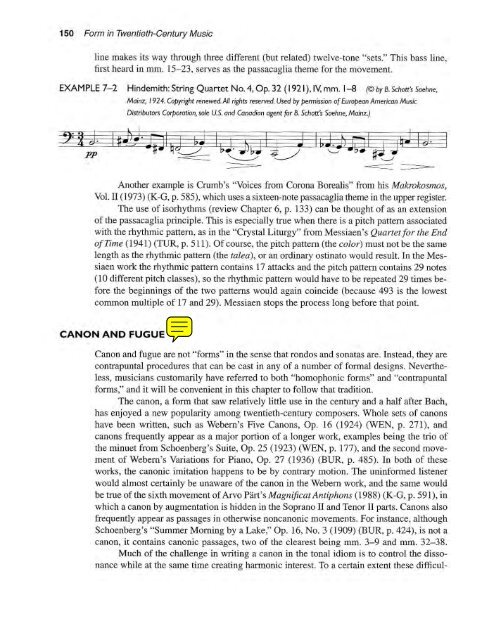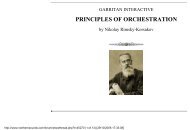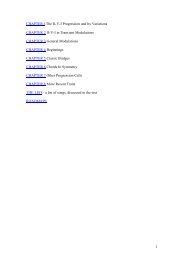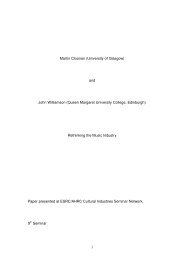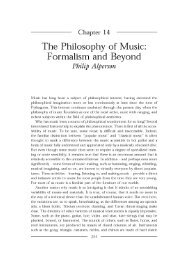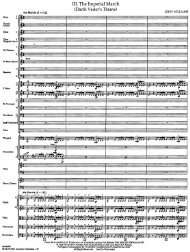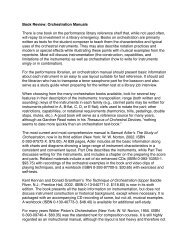TWENTIETH- - Synapse Music
TWENTIETH- - Synapse Music
TWENTIETH- - Synapse Music
You also want an ePaper? Increase the reach of your titles
YUMPU automatically turns print PDFs into web optimized ePapers that Google loves.
150 Form in Twentieth-Century <strong>Music</strong><br />
line makes its way through three different (but related) twelve-tone "sets'-' This bass line,<br />
first heard in mm. 15- 23, serves as the passacaglia theme for the movement.<br />
EXAMPLE 7-2 Hindemith: String Quartet No.4, Op. 32 (1921), IV, mm. 1-8 (© by B. Schott', Soehne.<br />
Mainz, 1924. Copyright renewed. All rights reserved. Used by pennission of European American <strong>Music</strong><br />
Distributors Corporotion, sole U.S. and Canadian agent for B. Schott's Soehne, Moinz.)<br />
- -<br />
Another example is Crumb's "Voices from Corona Boreali s" from his Makrokosl1ws,<br />
Vol. II (1973) (K-G, p. 585), which uses a sixteen-note passacaglia theme in the upper register.<br />
The use of isorhythms (review Chapter 6, p. 133) can be thought of as an extension<br />
of the passacaglia principle. This is especially true when there is a pitch pattern associated<br />
with the rhythmic pattern, as in the "Crystal Liturgy" from Messiaen's Quartet/or the End<br />
a/Time (1941) (TUR, p. 511). Of course, the pitch pattern (the color) must not be the same<br />
length as the rhythmic pattern (the lalea), or an ordinary ostinato wo uld result. In the Messiaen<br />
work the rhythmic pattern contains 17 attacks and the pitch pattern contains 29 notes<br />
(10 different pitch classes), so the rhythmic pattern would have to be repeated 29 times before<br />
the beginnings of the two patterns would again coincide (because 493 is the lowest<br />
common multiple of 17 and 29). Messiaen stops the process long before that point.<br />
CANON AND FUGUE<br />
Canon and fugue are not "forms" in the sense that rondos and sonatas are. Instead, they are<br />
contrapuntal procedures that can be cast in any of a number of form al designs. Nevertheless,<br />
musicians customarily have referred to both "homophonic forms" and "contrapuntal<br />
forms," and it will be convenient in this chapter to follow that tradition.<br />
The canon, a form that saw relatively little use in the century and a half after Bach,<br />
has enjoyed a new popularity among twentieth-century composers. Whole sets of canons<br />
have been written, such as Webern's Five Canons, Op. 16 (1924) (WEN, p. 271), and<br />
canons frequently appear as a major portion of a longer work, examples being the trio of<br />
the minuet from Schoenberg's Suite, Op. 25 (1923) (WEN, p. 177), and the second movement<br />
of Webern's Variations for Piano, Op. 27 (1936) (BUR, p. 485). In both of these<br />
works, the canonic imitation happens to be by contrary motion. The uninformed listener<br />
would almost certainly be unaware of the canon in the Webern work, and the same would<br />
be true of the sixth movement of Arvo Part's Magnificat Antiphons (1988) (K-G, p. 591), in<br />
which a canon by augmentation is hidden in the Soprano II and Tenor II parts. Canons also<br />
frequently appear as passages in otherwise noncanonic movements. For instance, although<br />
Schoenberg's "Summer Morning by a Lake," Op. 16, No. 3 (1909) (BUR, p. 424), is not a<br />
canon, it contains canonic passages, two of the clearest being mm . 3-9 and mm. 32-38.<br />
Much of the challenge in writing a canon in the tonal idiom is to control the dissonance<br />
while at the same time creating harmonic interest. To a certain extent these difficul-


